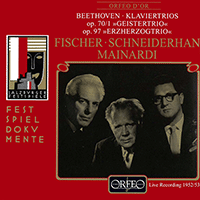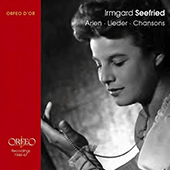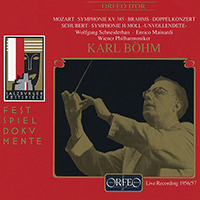Wolfgang Schneiderhan
Though never known as a great virtuoso, Wolfgang Schneiderhan was considered a stylish and thoughtful musician, appearing with his own trio and string quartet as well as with many great conductors and celebrated pianists throughout his career. He held the Viennese tradition in high regard and consciously nurtured an artistic ethos inherited from the likes of Joachim, Auer and Kreisler. The latter he considered not only a great violinist but also a philanthropist and champion of worthy causes; in 1992 he established the first Austrian violin competition in Kreisler’s name.
Having begun violin lessons with his mother at three and given a public recital at five, he went to Czechoslovakia to study with the controversial Otakar Ševčík whom Schneiderhan accused of wanting to turn his pupils into Paganinis, and of drilling rather than teaching. Reacting to this, he completed his studies in Vienna with Julius Winkler who encouraged a more creative, artistic approach.
Schneiderhan’s years as leader of two of Vienna’s orchestras are interesting in the light of his belief that it was important for young musicians to gain orchestral experience: ‘It teaches you to listen—how long the wind and brass have to breathe. It is like playing in a string quartet. The benefits are slightly different, but complementary.’ As a quartet player, Schneiderhan shows himself on record to be capable of the very modern art of creating a homogenous, unified sound. The Schneiderhan Quartet’s 1949 recording of Beethoven’s Op. 95 is suitably direct and driven with good pacing and a rather dry but well-projected sound that particularly suits the unison writing in the first movement.
In the early 1950s Schneiderhan decided to concentrate on solo playing. His performance of Bruch’s G minor Concerto from 1952 is nothing if not interesting in terms of both tempo and ensemble: there are recollections of an earlier style (restrained vibrato; un-notated tempo shifts; a number of expressive portamenti) which sit a little uneasily with a clearly mid-twentieth-century understanding of tone production and relative literalism in translating notation to sound. Such performances preserved on record are real gems to the performing-practice historian!
During his extensive recording career Schneiderhan was known mainly for playing Mozart, Beethoven and Schubert, recording all Mozart’s violin concertos as soloist and director with the Berlin Philharmonic Orchestra. He also recorded Beethoven’s Violin Concerto, for which he wrote his own cadenza, at least six times, represented here by a live 1964 performance. His recording of Beethoven’s Op. 47 sonata (part of a 1952 complete cycle with Kempff) testifies to a carefully-considered manner of playing such Classical chamber works—a spare, architectural style with economical use of the molto-vibrato sound popular amongst his generation—albeit without the eccentricities of some of his concerto recordings. In later Romantic music such as the 1956 live Brahms sonata performance here, he seems a little heavy-handed, with some very wide and exaggerated vibrato and over-emphatic accents.
Schneiderhan said of contemporary works: ‘Music does not stop with Debussy or Respighi. Modern music will only die if it is not good music.’ Having married the soprano Irmgard Seefried in 1948 he performed a number of contemporary works with her, including Frank Martin’s Magnificat in 1968, written for and dedicated to them. Schneiderhan was a convincing advocate of Martin’s Violin Concerto, recording it in 1952 and again displaying the kind of dry, almost academic style found elsewhere; his solidity of tone in the finale is particularly impressive. Schneiderhan’s discography is a faithful testament to his eclectic taste, enterprising programming and distinguished career.
© Naxos Rights International Ltd. — David Milsom (A–Z of String Players, Naxos 8.558081-84)

























